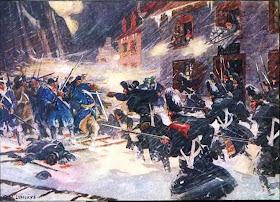 |
| The Battle of the Chesapeake |
In 1763, the British signed off on the peace treaty which secured the domination of their global empire. The peace of Paris, in 1763, gave French Canada to the British. This ended the Seven Years' War, and to us, today, seems to signify the end of the Imperial Wars period. After all, the next war, the American War of Independence, was not an Imperial War at all- it was a fight between the English speaking people of North America, and the English speaking people of Great Britain, right?
It turns out, this is not really the case. The American War of Independence was just one facet of a much larger war. In this war, the British found themselves pitted against an alliance of the rebellious colonists, the French, Spanish, Dutch, and Native Americans. In this war, the British were joined by the western German states who had supported them for much of the eighteenth century.
The opening stages of this war will be familiar to many of my American readers- after all, in America, we learn about the first shots at Lexington and Concord. However, many of the events of this global war will seem very unfamiliar. I will refer to this as the global, "Eight Years' War," 1775-1783.
The single most important battle of this global conflict was the Battle of Saratoga in 1777, which resulted in the surrender of the Northern British army under General Burgoyne. This directly led to the entry of France into the conflict, on the side of the rebellious American colonists. The war immediately took on a global aspect. On the 27th of July, 1778, the French and British fleets met in the naval battle of Ushant. Also in July, the French captured Grenada from the British. A young Swedish officer, Kurt von Stendingk, who served with the French, recalled his experiences of the attack on the fortress at Grenada:
"We marched without firing a shot, palisades were torn down, the entrenchments carried one after the other, the charge was beaten, and wounded and dying in chorus shouted, "Long live the king!" It is difficult to imagine how the soul is exalted in these times, and how man becomes more than man: each soldier was a hero."
This Swede was not fighting for American Independence-he was fighting as a participant in a traditional eighteenth century
Kabinettskriege. While he would later be made a member of the Society of the Cincinnati, his loyalty remained French.
 |
| Cowpens by Don Troiani |
The French also fought the British fleet off the coast of America, and the most decisive battle of the war was the Battle of the Chesapeake- pictured in the painting at the top of the post. In this battle, the French prevented the British fleet from rescuing Lord Cornwallis' forces. The French also provided the necessary siege guns to bombard the British in Yorktown. For those who believe that divine providence played a role in America's Independence, make sure that God is thanked for French cannon. They played a much larger role than the tactical skills of George Washington.
In addition to fighting in North America, the Caribbean, and the oceans of the world, fighting also took place in India. The French and British fought in India starting in 1778, and the Dutch joined the war in 1780. From 1781-1783, the French and British fought a bitter conflict in India, with neither side gaining much ground. These campaigns were mostly composed of sieges, and naval battles.
I have already discussed the
Spanish operations in North America during the Eight Years' War, but let me say a few words the Siege of Gibraltar. This siege lasted from 24th of June, 1779, to the 7th of February, 1783, or over three years and seven months. The mountain fortress of Gibraltar was besieged by a combined arms force of the French army and navy, and managed to hold out.
In 1778, another war broke out, the War of Bavarian Succession. Fought between Austria and Prussia, this war was also an attempt continue the imperial struggle started in the Seven Years' War. Prussia was attempting to play a greater role in the politics of the Holy Roman Empire, by pressuring the Austrians, who were in turn, attempting to create allies within the HRE.
Thus, while the conflict started in North America, in the relatively familiar venue of Lexington and Concord, the Eight Years' War was truly a global conflict. After the opening stages in North America, the conflict spread to the coasts of France and Spain, Gibraltar, the Caribbean islands, Central Germany, and India. Individuals were involved from across the world: from Native Americans, to African slaves, to Sepoys from India, to American Colonists, to Swedes like Kurt von Stedingk. However, for some reason, this conflict is viewed as minor part of the American War of Independence. Is it not more likely that the American War of Independence was simply part of this larger conflict, which happened to start in North America? While certainly vital for the development of America, it is important that we do not view this war as simply an American affair.
Thanks for reading,
Alex Burns







.JPG)















